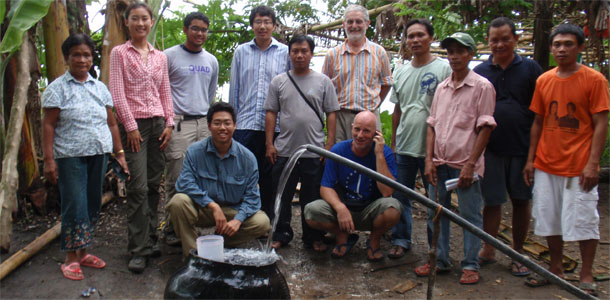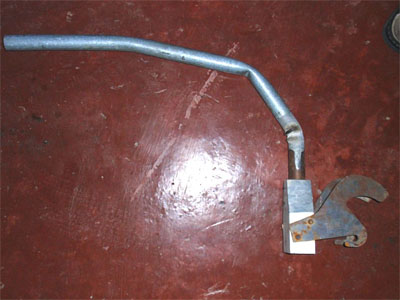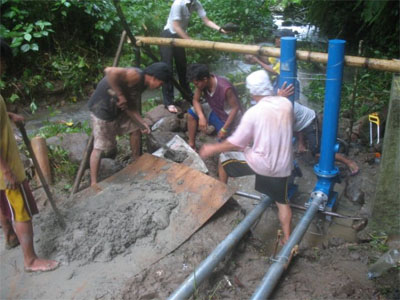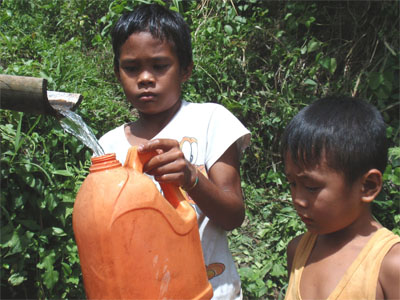Engineers for a Sustainable World Builds Ram Pumps in Philippines

When Engineers for a Sustainable World member Junzi Shi arrived in the rural village of Tres Hermanos in the Philippines last summer, she quickly learned that “booksmarts weren’t that applicable.”
As part of a team that was building a water pump for the village, Shi found that her anthropology education didn’t prepare her for the snakes, torrential rain, and manual labor that filled her month-long trip.
“We learned about the realities of working in the developing world,” Shi said. “You just have to go with the flow and come up with innovative solutions.”
But Shi was prepared for the tenacity it would take to make the two-kilometer-long ram pump possible. It was Shi who originally connected with the local NGO, Alternative Indigenous Development Foundation Inc. (AIDFI), who managed the project and whose technicians guided the construction of the project. Shi also built and tested prototypes, recruited students for the team, and led the fundraising necessary to make the pump and the trip possible.
“I wanted to help create a project where we could build not only a pump, but also a lasting relationship with the community,” Shi said.
The project began after Shi, who previously installed biogas digesters in Nicaragua and Peru, met with the AIDFI director Auke Idzenga, who told her about their flagship technology — the hydraulic ram pump — and the organization's mission to reduce poverty in the rural Philippines. The ram pump system forces water from the lower Anangue Spring to higher elevations utilizing the water hammer effect, which applies the kinetic energy of the input flow and a pressurized chamber to pump water through the uphill delivery line. (AIDFI and their ram pump technology were recently named the winner of BBC World News’ World Challenge 10 series.) This saved villagers the need to walk a half hour to get to fresh water. Shi said that she and her colleagues could help optimize the ram pump to make it more efficient and could help construct a pump in rural Tres Hermanos.
Engineers for a Sustainable World encourages cross-disciplinary teams for their projects, and Shi collaborated with a rotating group of engineering students to make the pump more efficient by modeling the system in MATLAB. When that proved to be too difficult, they settled on creating a new lever mechanism that would make the valve of the ram pump safer.
 “When you prime the pump, the door of the pump needs to open and shut several times, but as it was designed, the release of the door caused it to snap so quickly that your hand or foot could get hurt in the process,” she said.
“When you prime the pump, the door of the pump needs to open and shut several times, but as it was designed, the release of the door caused it to snap so quickly that your hand or foot could get hurt in the process,” she said.
During winter, Shi worked for part of her break in the lab of Aaron Packman, professor of civil and environmental engineering and the group’s adviser, to build a prototype.
“We didn’t realize how complicated it could be,” Shi said. “If something didn’t work, we couldn’t ask other students or researchers at Northwestern. We had to figure it out ourselves.”
In the spring, the team, (now solidified as Shi, and engineering students Joseph Park, Jonathan Lamano, and David Zhou) raised the $30,000 needed to make the pump possible through grants from the Department of Civil and Environmental Engineering, the Initiative for Sustainable Energy at Northwestern, the Northwestern Alumnae Association, Dow Chemical, and International Project Development. With the help of graduate students Antoine Aubeneau and Jen Drummond, the team even won a $10,000 prize in the Dow Sustainability Innovation Challenge. Finally, they were ready to travel to the Philippines on June 21 to help install the pump.
After an hour-long Jeep trip on unpaved roads, the four arrived in the community of Tres Hermanos, where most of the villagers had never seen foreigners before.
“They were really curious and friendly,” Shi said. The students stayed in a villager’s home and hired two local boys as cooks. They ate their meals — mostly rice, with some canned meat and vegetables— with the locals and the AIDFI technicians, and spent their days clearing brush, hauling rocks, and helping to build cement tank structures for the ram pump.
 Over the next three weeks, the students finished construction of the system and visited each villager’s home to survey them about the pump. A few had not even heard of the pump installation, and many were curious why they couldn’t connect water directly to their homes. (The answer: there was not enough water for everyone to use for activities like bathing and watering crops, so villagers had to share water at the tap stands at certain times of day.)
Over the next three weeks, the students finished construction of the system and visited each villager’s home to survey them about the pump. A few had not even heard of the pump installation, and many were curious why they couldn’t connect water directly to their homes. (The answer: there was not enough water for everyone to use for activities like bathing and watering crops, so villagers had to share water at the tap stands at certain times of day.)
On the weekends the students took a break from construction and visited local sites. It was here they learned about the Filipino way of life: anything can happen. The students survived engine breakdowns, getting stuck in the mud, and having to push a truck uphill. When the group took an outrigger canoe ride out to an island for some tropical relaxation, they ended up getting stuck on a coral reef for 10 hours and then capsizing a small fishing boat in the dark.
Finally, when the construction was finished, the students tested and optimized their new lever. In order for the pump to work, it needed to be primed. In previous ram pumps, technicians would manually open and close the waste valves to begin pumping. Because this pump was so large, technicians could no longer open the valve manually without the risk of getting caught in the door. The Northwestern student-designed lever both protected the user and allowed the user to more easily open the valve.
When the water first traveled up the delivery lines and into the village, the pipe was placed on a tree, and a large group gathered to shower under it.
“There were little kids and old ladies who came in their clothing and just jumped in,” Shi said. “And then we showered after them. I think that was the moment where we thought, this is awesome. We did something good for this village.” The ram pump system now delivers approximately 50,000 liters of water per day to the village’s 48 households.
Before they left, the students and the AIDFI technicians helped the village form a water committee that would assess maintenance fees and keep a reserve in case the pump required new parts.
“I am very proud of the team and how much we were able to accomplish in the field, in large part due to the hospitality of our hosts, AIDFI and Tres Hermanos,” Shi said. “We made really strong bonds on this trip, and all groups involved feel the desire to continue the relationship.”
